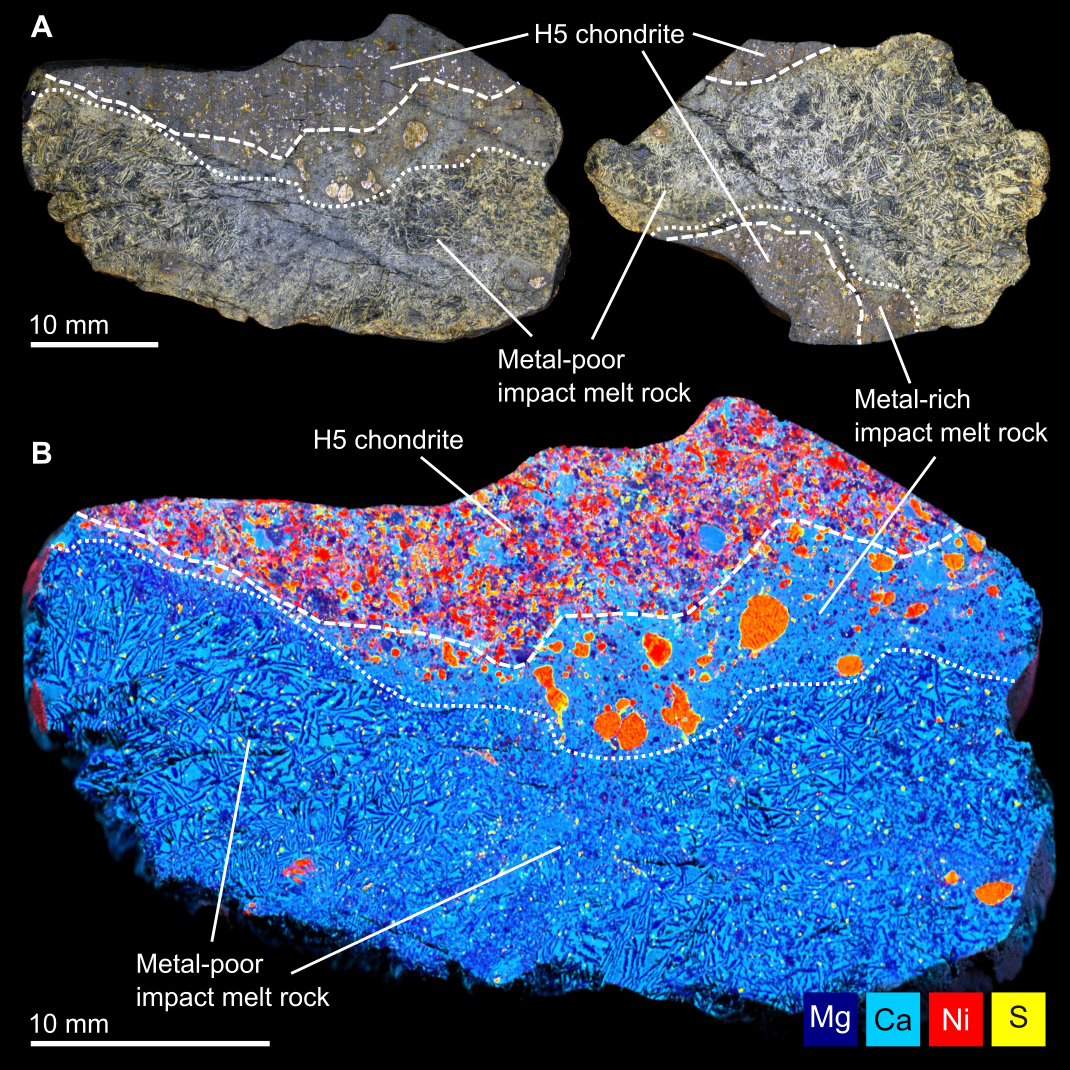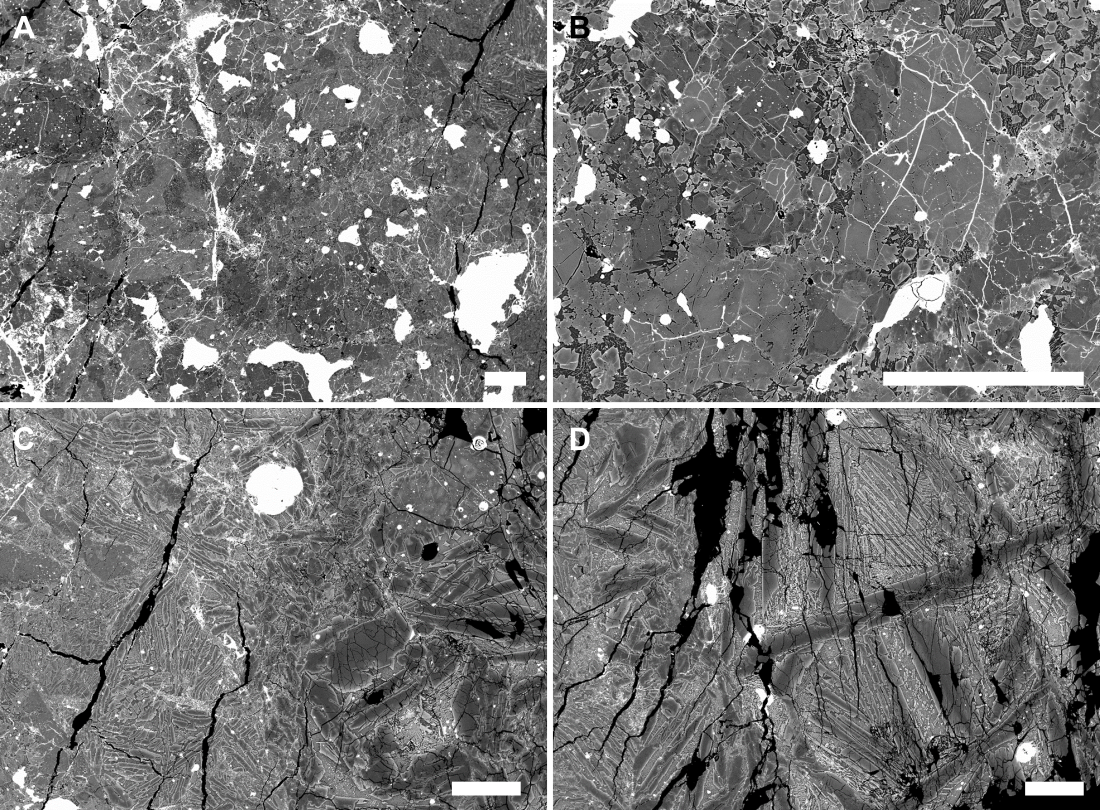Hypervelocity collisions as drivers of planetary differentiation: Evidence from the Boutel Fil (b) H chondrite impact melt breccia
- 1Museum für Naturkunde, Berlin, Germany (christopher.hamann@mfn.berlin)
- 2Institut für Geologische Wissenschaften, Freie Universität Berlin, Germany
Introduction
Meteorites are commonly divided into two principal groups: chondrites, which represent unmelted accretionary aggregates, and achondrites, which are products of melting and planetary differentiation [1]. The coexistence of chondrites and achondrites is traditionally interpreted as the result of a spatial and/or temporal dichotomy in the population of planetesimals in the early solar system [2–4], and it is consequently envisaged by meteorite classification schemes that no single planetary body could be the parent body of both chondritic (i.e., unmelted) and achondritic (i.e., melted) meteorites. Yet, evidence of protracted accretion and partial differentiation of planetary bodies exists in the meteorite inventory, as recently illustrated for the parent body of the IIE iron meteorites [5]. While initially refuted based on the view that hypervelocity impacts did not facilitate widespread melting of cold planetesimals [6], hypervelocity impacts onto chondritic parent bodies during early time steps of solar system history, when heat-producing decay of short-lived radionuclides was ongoing, might have governed partial differentiation of chondritic planetary bodies [7–9]. A few individual H chondrites such as Pultusk [10] and Gao-Guenie [11], several meteorites recovered from LaPaz Icefield [12], and anomalous achondrites such as Dar al Gani 896 [13] might indeed show direct evidence of this process. However, it has remained unclear if hypervelocity impacts could have facilitated partial planetary differentiation as envisaged, for example, for the asteroid 6 Hebe [7]. Here we report on the H5 melt breccia Boutel Fil (b), which next to unmelted domains of H5 chondrite composition contains abundant achondritic domains of impact-melt origin in which metals and silicates separated in the liquid state.
Results
Boutel Fil (b) was found while searching for meteorites in the Boutel Fil strewn field, Chari-Baguirmi, Chad. It was recognized because it looks strikingly different from the fresh LL6 Boutel Fil chondrite individuals that form the strewn field. It is also distinct from the nearby Djermaia H3–6 chondrite. Petrographic analysis revealed that Boutel Fil (b) is a partly fusion-crusted, chondritic melt breccia composed of H5 regions in abundant melt rock matrix (Fig. 1A). The H5 regions are crosscut by shock melt veins and contain partly flattened chondrules with a mean diameter of about 0.3 mm (Fig. 2A). Olivine in the chondrules is Fa18.1.

Fig. 1 Boutel Fil (b). A Overview images of two different slices of the meteorite. B µXRF element distribution map of one of the meteorite sections, showing the distribution of Mg, Ca, Ni, and S.

Fig. 2 Backscattered electron images of the different domains in Boutel Fil (b). A Unmelted H5 domain with chondrules and shock veins. B Fine-grained, metal-rich impact melt rock with zoned olivine and low-Ca pyroxene, interstitial mesostasis, and metal blebs and veins. C Transition between the fine-grained, metal-rich impact melt rock (left) and the coarse-grained, metal-poor impact melt rock (right). D Coarse-grained, metal-poor impact melt rock with zoned olivine quench crystals and interstitial mesostasis. Scale bars are 100 µm.
The unmelted H5 regions transition into a metal-rich, fine-grained melt rock composed of zoned olivine, low-Ca pyroxene, interstitial mesostasis, and large FeNi metal–sulfide blebs between <1 and ≤10 mm across (Figs. 1 and 2B). Adjacent to this metal-rich melt rock, a distinctly metal-poor, coarse-grained melt rock exists that is composed of large, normally zoned quench crystals of olivine (Fa8.2–37.5; average: Fa18.7) and mesostasis (Figs. 1 and 2C, D). Small sulfide blebs occur in the coarse-grained melt rock, whereas FeNi metal blebs are almost absent (Fig. 1B).
Major-element abundances of the H5 regions, obtained by micro X-ray fluorescence (µXRF) analysis using a defocused beam spot size of 200 µm, are chondritic. In contrast, the metal-poor, coarse-grained melt rock is significantly depleted in siderophile and chalcophile elements (Ni, Co, S, and Fe) and enriched in lithophile elements (Cr, Mn, Si, Mg, Na, and Al) compared to the H5 regions; the FeNi metal blebs have a complementary composition. In addition, the composition of the metal-poor, coarse-grained melt rock is remarkably similar to anomalous achondrite Dar al Gani 896 [13], which is interpreted as the silicate portion of an impact melted, metal–silicate segregated H chondrite precursor.
Discussion
We interpret Boutel Fil (b) as an impact melt breccia that formed in an impact event large and energetic enough to facilitate bulk melting of the H5 regions, which required peak pressures in excess of 70–80 GPa [14]. Agreeing with hypotheses of [13], we attribute metal–silicate segregation in the liquid state either to velocity differences between dense metal and lighter silicate impact melts during transient crater formation and/or to gravitational settling of dense metal liquids. Interestingly, the metal droplets in the metal-rich, fine-grained melt rock portion of Boutel Fil (b) have sizes that would be commensurate with the gravitational settling scenario envisaged by [13]. Rapid cooling of impact melt close to the relatively cold H5 regions, as evidenced by smaller grain sizes compared with the coarse-grained melt rock regions (Figs. 1 and 2), likely arrested metal droplets before complete segregation. We conclude that Boutel Fil (b) and Dar al Gani 896 demonstrate that hypervelocity impacts must be considered as potential drivers of (partial) planetary differentiation, likely predominantly during early stages of solar system history.
References
[1] Krot A. N. et al. (2014) Treatise on Geochemistry, edited by Holland H. H. and Turekian K. K, 1:1–63.
[2] Mason B. (1967) American Scientist 55:429–455.
[3] Hevey P. J. and Sanders I. S. (2006) Meteoritics & Planetary Science 41:95–106.
[4] Scott E. R. D. (2006) Icarus 185:72–82.
[5] Maurel C. (2020) Science Advances 6:eaba1303.
[6] Keil K. et al. (1997) Meteoritics & Planetary Science 32:349–363.
[7] Gaffey M. J. and Gilbert S. L. (1998) Meteoritics & Planetary Science 33:1281–1295.
[8] Elkins-Tanton L. T. (2012) Annual Review of Earth and Planetary Sciences 40:113–39.
[9] Ciesla F. J. et al. (2013) Meteoritics & Planetary Science 48:2559–2576.
[10] Krzesińska A. (2017) Meteoritics & Planetary Science 52:2305–2321.
[11] Schmieder M. et al. (2016) Meteoritics & Planetary Science 51:1022–1045.
[12] Wittmann A. et al. (2010) Journal of Geophysical Research 115:E07009.
[13] Folco L. et al. (2004) Geochimica et Cosmochimica Acta 68:2379–2397.
[14] Stöffler D. et al. (2018) Meteoritics & Planetary Science 53:5–49.
How to cite: Hamann, C., Rice, P., and Greshake, A.: Hypervelocity collisions as drivers of planetary differentiation: Evidence from the Boutel Fil (b) H chondrite impact melt breccia, Europlanet Science Congress 2024, Berlin, Germany, 8–13 Sep 2024, EPSC2024-826, https://doi.org/10.5194/epsc2024-826, 2024.